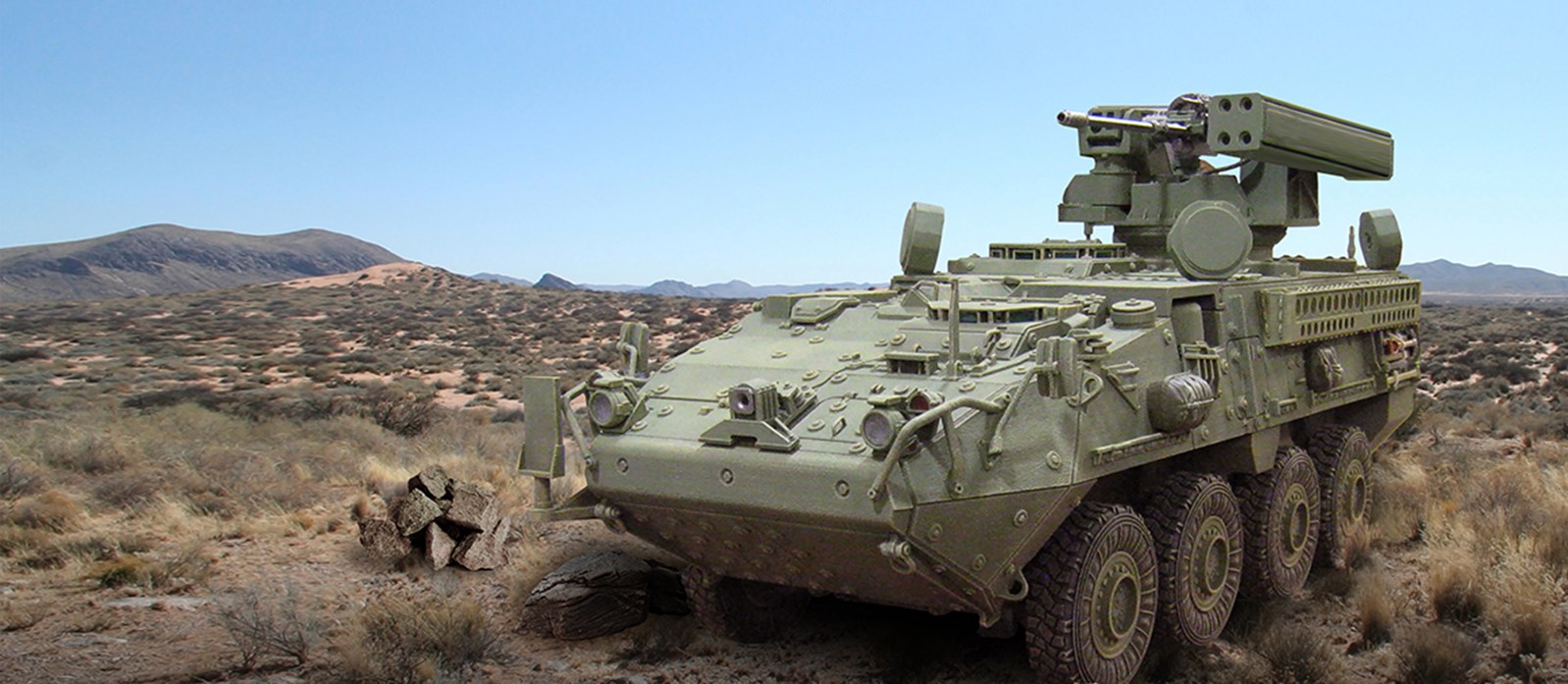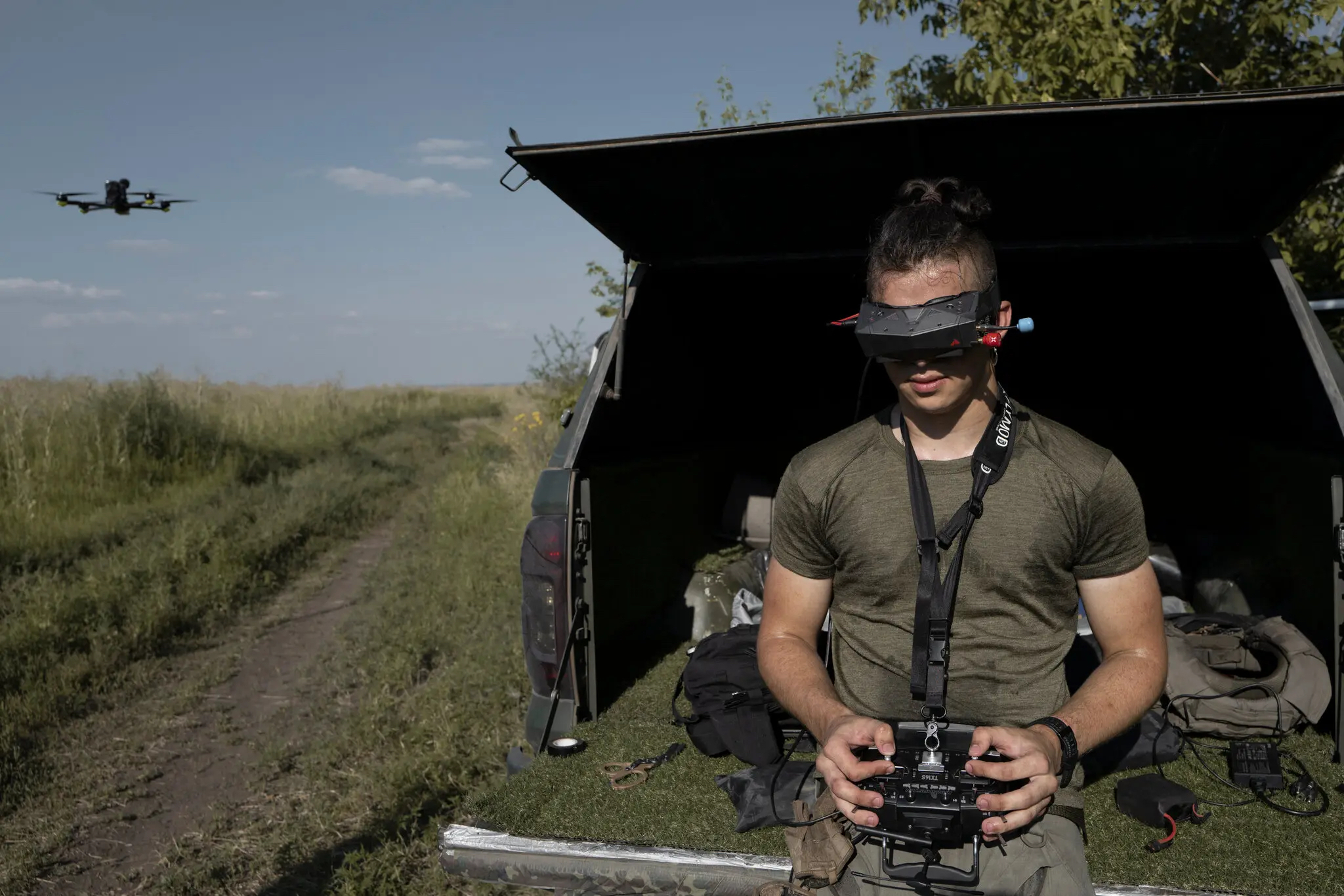M-LIDS sensors and effectors are currently employed on two M-ATVs; Leonardo DRS leads an integration effort to consolidate the capability onto one Stryker.
Drones continue to become more capable and more dangerous. They’re being deployed effectively for surveillance and attack by both sides of the on-going conflict in Ukraine. Drones are impacting each side’s ability to maneuver ground forces, and Russia has used them extensively to attack critical infrastructure to shape the will of the Ukrainian people.
To address this new battlefield reality, the US Army, in particular, is leading the way in providing warfighters with Counter-Unmanned Aircraft System (C-UAS) capabilities. One of its priorities is the mobile C-UAS program known as Mobile, Low, Slow, Small, Unmanned Aircraft Integrated Defeat System (M-LIDS). The Army identified M-LIDS Increment 2 as an ACAT III program of record about a year ago.
M-LIDS is configured with two mine-resistant ambush-protected (MRAP) all-terrain vehicles (M-ATV). One MATV employs on-board radar to detect and track threats and a remote turret with multiple kinetic effectors to defeat threats; the other vehicle carries non-kinetic electronic warfare technologies.
In this Q&A with Aaron Hankins, Senior Vice President and General Manager, Leonardo DRS Land Systems, we discussed the latest developments with M-LIDS, what the company brings to the program as lead vehicle integrator, and the effort it leads to reimagine the two-vehicle M-LIDS M-ATV package as a single M-LIDS Stryker.
Breaking Defense: What’s the background that led to Leonardo DRS becoming the lead integrator for M-LIDS?

Aaron Hankins, Senior Vice President and General Manager, Leonardo DRS Land Systems.
Hankins: This originated from a JUONS (Joint Urgent Operational Need Statement) several years ago when the Army was looking to design, develop, test, and field these systems at an accelerated pace. We recognized the urgency for all C-UAS efforts, and DRS brought to the program an ability to work through accelerated acquisition schedules and rapid prototyping. DRS has extensive integration experience on different platforms, including integrating masted and vehicle-mounted sensors, on-board and ruggedized computers, and different command and control networks.
Working with the US Army and several industry partners, we lead the effort to create a unique and innovative solution that integrates several complex technologies onto two M-ATVs. The vehicles, developed under the JUONS, have been through extensive testing over the years and are now deployed in operational environments protecting soldiers in the Middle East and Eastern Europe.
The Army has a requirement to rapidly field up to nine divisions with this capability, with each division receiving five sets of MLIDS. We are in the process of building those vehicles now and fielding of the division sets begins next year. Leonardo DRS also provides CONUS and OCONUS support for those systems.
Breaking Defense: Tell us about the M-LIDS systems that you’re responsible for integrating onto the two M-ATVs.
Hankins: Most of the technologies for M-LIDS are government-furnished equipment. Leonardo DRS is responsible for integrating the technologies to ensure they work together, and we assemble and deliver the vehicles. Leonardo DRS also supports the on-going engineering testing to continue to improve M-LIDS being provided to soldiers. M-LIDS provides layered protection by employing non-kinetic and kinetic capabilities.
Our key partners include Moog who provides their Reconfigurable Integrated-weapons Platform (RIwP®) turret, Raytheon for the on-board radar, and SRC for the electronic warfare technology. The RIwP turret includes a high-quality Leonardo DRS EO/IR sensor and Northrop Grumman’s XM914 (30mmx113mm) cannon which has been proven very effective against drones using proximity-fused ammunition. The turret also hosts Raytheon’s Coyote missile, and these kinetic effectors can defeat Group 1 through Group 3 UAS at very long ranges.
Breaking Defense: You are displaying a single vehicle version of M-LIDS on a Stryker. How did that idea evolve?
Hankins: We started the Stryker M-LIDS discussion with the Army about 18 months ago. The goal was to consolidate effective C-UAS technologies on a single vehicle. In this case, we used the Stryker, but the C-UAS mission equipment package would work on other similar platforms.
Last year, Leonardo DRS, with help from seven industry partners and the C-UAS program office, designed, integrated, built, and tested the Single Vehicle C-UAS Stryker in less than eight months. The single vehicle provides the same capability as the current M-LIDS while also performing tasks that cannot be done with the two-vehicle solution.
Additionally, the Single Vehicle C-UAS Stryker is very similar to the Stryker-based M-SHORAD system. For M-SHORAD, General Dynamics Land Systems is the platform integrator and prime contractor. Leonardo DRS provides the mission equipment package that detects, identifies, tracks, and defeats Group 3 UAS, rotary wing and fixed wing threats.
The similarity with the M-SHORAD Stryker is helpful as the Army is considering fielding the mobile C-UAS capability in M-SHORAD battalions. Obviously, a common vehicle with an established sustainment base also helps the Army.
As the Army considers fielding mobile C-UAS to maneuver brigade combat teams (BCT), the Single Vehicle C-UAS Stryker would easily integrate into the Stryker BCT, providing C-UAS protection and enhanced direct fire lethality at the platoon and company level. A common platform also helps the Army manage the training burden for soldiers and units.

The Single Vehicle C-UAS Stryker makes sense for Brigade Combat Teams as it is common with the M-SHORAD Stryker shown here and requires fewer soldiers to operate. Photo courtesy of Leonardo DRS.
Breaking Defense: Does the single-vehicle system include the exact, same systems and capabilities presently integrated on M-LIDS vehicles, just compressed into a smaller package? Or is it a better capability?
Hankins: It does both. We’re working with a lot of the same industry partners and in many cases, we’ve taken the next generation or derivatives of those M-LIDS technologies and put them onto the single vehicle. We certainly looked to reduce the size, weight, and power demands when we consolidated the technologies onto the Stryker. The goal was to provide a one-vehicle solution that did not degrade the capability provided to soldiers, and the team was able to successfully demonstrate the same performance on one vehicle. In some cases, the single vehicle outperformed the current capability.
Another benefit to a single vehicle capability is it reduces the number of soldiers required to operate it from eight to three. Commanders are provided a mobile C-UAS with fewer soldiers required. It’s a win-win moving to a single vehicle.
It’s also worth noting this C-UAS mission equipment package was integrated onto a Stryker because we had access to this vehicle. It could also fit on a tracked platform. In fact, the mission equipment package could be integrated onto a variety of different platforms if they support the weight and the power requirements.
Breaking Defense: Putting on your vehicle integrator hat, describe your challenge on the Single Vehicle C-UAS program.
Hankins: At the top level, we had to get all the technology onto a single vehicle and retain the space for soldiers and their equipment. Power is always important, so you work with your partners to understand power demands and different peaks. EMI deconfliction is also very important when you’re using electronic warfare technologies. Finally, the capability had to be fully integrated into the Army’s Air Defense network, FAAD C2 (Forward Area Air Defense Command and Control).
As a vehicle integrator, it’s critical to work closely with your partners, understanding each technology, how it operates, and then how it communicates and potentially interferes with other technologies. The key is that all the technologies must be able to operate in concert with each other. For example, you don’t have the luxury of turning off electronic warfare that might be protecting you against an IED to engage a drone. Each technology provides a critical part of the mission equipment package.
We were able to take the single-vehicle Stryker to a government test in December. The system demonstrated what is in the realm of possible on a single vehicle and completed the government’s C-UAS objectives. We thought the test was very successful, and I believe the USG would agree.
Again, it’s informing requirements and providing an alternative to the two M-ATVs.
Breaking Defense: What’s next for the Stryker Single Vehicle C-UAS?
Hankins: The Army collected volumes of data on the C-UAS Stryker during the testing last December, and we are looking forward to the Army’s decision on a path forward. We know the single-vehicle version executes the C-UAS mission. That was proven under live-fire conditions during the test.
Transitioning to a single vehicle variant of M-LIDS makes sense. We think the Stryker makes sense as it is common with the M-SHORAD Stryker and requires fewer soldiers to operate. We were able to validate the integration of the mission equipment package on a single Stryker, but it would fit on other platforms too.
As we continue to work closely with our customer on this capability, we will remain a forward-thinking partner to provide them with the best available options to meet requirements and prepare them for future needs. Delivering the best mobile C-UAS capabilities to soldiers remains our top priority.


